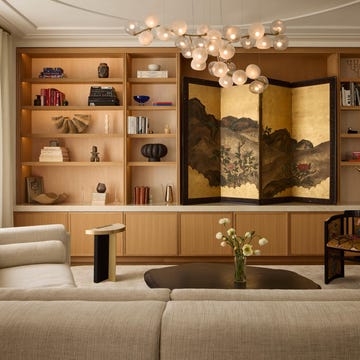‘This project was born through tragedy, but it became a celebration,’ explains filmmaker Robert Rafalat. He bought this late Victorian terrace in Finsbury Park, north London in 2013 with his sister, Zu Rafalat. But, in 2019, Zu fell ill, passing away the following year.
She left Rob a little money, which he wanted to put back into the house, starting with a new loft and a vague idea to give the rest of the space a paint refresh at the same time.
Feeling unsure about how to proceed he called on a good friend of his and Zu’s, Rhonda Drakeford of Studio Rhonda and online homeware store Darkroom. ‘I’ve always loved and coveted Rhonda’s work and it felt right that there was a link to Zu. And it completely spiralled from there’, says Rob with obvious amusement.
What's everyone reading?
Zu had decorated with whites and greys, as a backdrop for floral and tropical prints. ‘At the time, I went along with that for ease of life. But, as a filmmaker, I like things that are fast and strong and bright and punch you in the face. I wasn’t in the best of places but I thought, let’s go nuts and bring some joy to this house, create something as unique and new as possible.’
Rob’s initial idea was to use just the three true primary colours but, as well as broadening the range of blues, reds and yellows in use, Rhonda grounded these vivid tones against a neutral palette of earthy terracotta and plaster shades.
‘I normally encourage clients to be a bit more bold – Rob’s the first person I’ve had to tone down,’ she laughs.
The pair took an unusual approach to the house’s abundant period features: simply ignoring them. ‘They didn’t really fit with our plans, but there was no way I’d rip them out,’ says Rob.
The application of colour is playful and intuitive, with Rhonda’s signature method of using it architecturally, on ceilings and floors as well as walls. ‘I’ve treated it as a blank canvas, applying colour in an immersive way, rather than following what the architraves and mouldings are telling us,’ she explains.
Colours change, not at the edge of walls but at unexpected points, zoning the different functions of each room or offering an introduction to the shades to be encountered as you move through the house. This involved trialling hundreds of shades to create a palette of more than 30 colours, as well as all the correspondingly toned materials, from grouting to door handles. ‘There was a lot of sourcing on this project,’ says Rhonda, with understatement.
Many of the decorative choices were informed by key pieces in each space. In the dining room, a vintage circus poster of Zu’s was Rhonda’s starting point for the rich palette, while the living room’s blue sofa inspired her to create a ‘big blue cave’ for Rob to use as a screening room for his work.
‘It’s good to be in the same house, but for it to be so different, in a way that my sister would be up there cackling about,’ says Rob. ‘Before they come round, people imagine it’s going to be a clown house, but everyone says it’s actually a really calming space. And it makes me smile.’ studio-rhonda.com

















